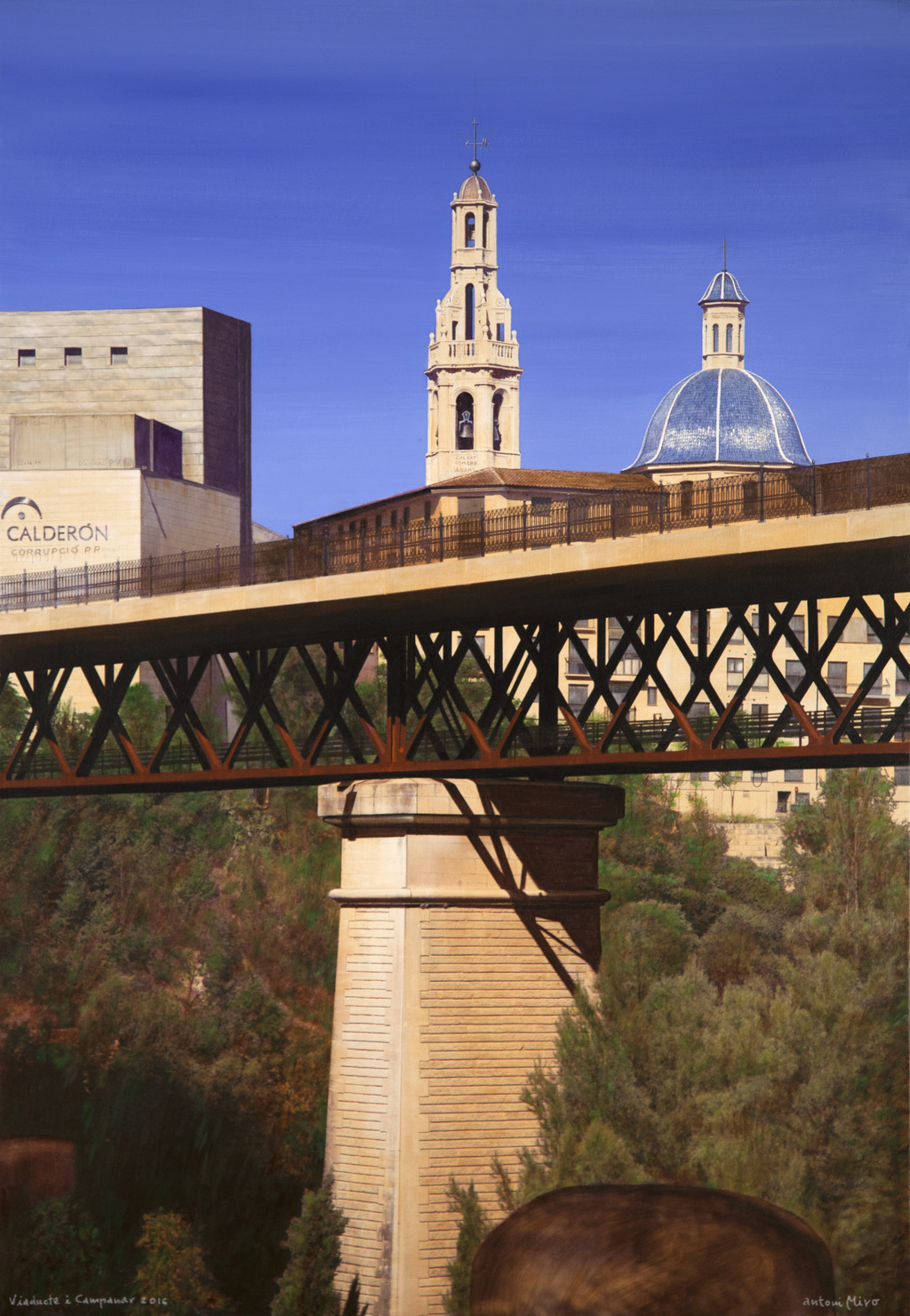Viaducte i campanar (Viaduct and bell tower)
This painting shows a current representation of a typical urban scene in Alcoi and forms part of the “Slopes and Bridges” series. It contains partial views of the elevation of the Canalejas viaduct and the bell tower and the dome of Santa Maria church. This is a typical image since this bridge was built in 1907, and it shows the contrast between the modern world, and the old one enshrined in Alcoi’s town centre.
Following the tradition of the vedute, one can recognise in multiple occasions a paradoxical situation. This comes from the fact that the degree of faithfulness to reality is highly variable depending on which areas or elements of these urban landscapes are being depicted in each part of the image that the artist is building. This is so in this work. For example, there is the accurate representation of minor elements that actually exist (swallows’ nests, damp stains, a hanging cable), and also the deliberate omission of others (lamp posts, the joints of the impost, pipes under the walkway), or the depiction of some comments added as criticism.
The deliberate selection and alteration of parts of the image that might be noted by the viewer from that point of view may serve diverse goals. In this case, he uses an irony-laden stance with which he refers to the interplay between reality and fiction, acknowledging — like Magritte — that the representation of an object or a scene is dissociated from the real thing. That is because it is the artist who, with their unique gaze, deliberately re-constructs things following certain keys.
In compositional terms, two main axes in the picture are obvious at first glance, which organise the picture and cross in the centre of the canvas. The vertical axis comprises the bridge pillar, and the bell tower of Santa Maria church in the background. This axis is an emphatic one yet also exhibits lightness despite the heaviness of the masonry that makes up its elements. The horizontal axis is formed by the metal lattice that forms the lintels of the viaduct spans. This last alignment splits the picture into an upper half, in which the sky fills all the gaps between the buildings. In the lower half, the gaps between the elements are filled with trees. This cross-over scheme formally ties together the whole composition.
However, Miró introduces irony in the hyper-realistic representation of the main built bodies (the bridge, the church, the dwellings and the theatre). He also resorts to a kind of fake (for instance, the metal lattice work used for the lintel is a reinterpretation of the original executed in 1985). These fakes take several forms.
On the one hand, the painter implies that he cannot help but reserve some areas at the bottom, supposedly because of foreground obstacles that stop him capturing background areas. He therefore tries to give verisimilitude to the idea of painting the work au plein air. On the other hand (and more importantly), he adds several textual graffiti to furnish additional information regarding two matters. One graffiti refers to a case of political corruption in the construction of the Calderón Theatre. The other graffiti (of a different scope) on the bell tower reads “CALCAT COM ERA ABANS” [Just like it used to be]. This warns the viewer that the tower is a reproduction of the one that stood there before. Finally, there are some references to the Valencian Country. This is achieved by using traditional pictorial uses to depict the present day. In the future, any ill-informed viewer will be made aware that the theatre is tainted with grand theft and that the bell tower is just a modern copy. He will also discover that, despite all appearances to the contrary, the picture was painted in the artist’s studio.
Santiago Pastor Vila
